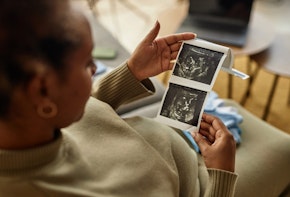Imagine what would be possible if the United States adopted public and workplace policies that prioritized mothers and their children. What would our lives look like if we truly invested in their health and well-being; supported both financial security and time to care; provided affordable, high-quality child care; and demanded cultural norms that ease the path to both work and care? We would have healthier, economically secure families and thriving babies and communities. Unfortunately, that is not our current reality. Instead, the United States has a maternal and infant mental health crisis that must be addressed.
In 2022, the year that the United States’ National Maternal Mental Health Hotline was launched, it received more than 12,000 calls and texts from mothers seeking support, and averaged more than thirty-two contacts every day.1 Pregnancy, delivery, and the adjustment to parenting an infant can be highly rewarding experiences, but they can also be physically and psychologically challenging. Mental health struggles during this period are common, affecting about 20 percent of mothers.2 These challenges take many different forms, can appear at various points throughout pregnancy and postpartum, and are one of the leading causes of pregnancy-related deaths, the vast majority of which are preventable.3 In addition, maternal mental health has an impact on infant development: recent research suggests that maternal depression, for instance, may have a significant impact on the structure and function of the child’s developing prefrontal cortex, which lays the foundation for broader cognitive ability.4
Addressing these challenges and supporting mothers’ mental health is a moral imperative. It also saves lives and supports infants’ healthy development, with lifetime benefits. This report describes the current state of policies supporting maternal and infant mental health, then takes an intersectional lens to examine how the COVID-19 pandemic and systemic racism have each exacerbated the challenges for all, and even more so for already marginalized groups. The report ends with a suite of policy recommendations that will help ensure strong maternal and infant mental health for everyone.
The Maternal and Infant Mental Health Landscape
CDC researchers find that approximately one in eight women suffer from postpartum depression, a condition which can include persistent worry or anxiety, feelings of anger, doubt about the ability to care for the baby, or thoughts of self-harm or harm to the infant. Half of known cases go without treatment.5 Moreover, it is important to note that a true statistic of postpartum depression rates is unknown, because many people who suffer do not recognize their symptoms as related to the condition, and, because maternal mental health issues can manifest in other ways, such as anxiety, post-traumatic stress disorder, and psychosis. Many people also face stigma about sharing their mental health challenges, making them more reluctant to report their struggles and therefore less likely to receive treatment.6
Mental health challenges during pregnancy, however, can threaten fetal development, and can even shorten the gestational period, resulting in premature delivery (before thirty-seven weeks).7 Many internal organs, including the brain, lungs, and liver, are still developing even during the final weeks of pregnancy; the earlier during pregnancy that preterm birth takes place, the higher the risk that the infant will not survive, or will be left with lasting developmental challenges.8 Elevated maternal stress during pregnancy is also associated with other risky birth outcomes, such as low birthweight, which is itself a risk factor for later intellectual or developmental delays. Elevated levels of cortisol—a hormone released in response to psychosocial stress—during pregnancy have been linked to later child behavioral outcomes, including increased fussiness, fearfulness in infancy, and higher reactivity in childhood.9
Children’s mental health, even during the earliest years of development, directly shapes their social and emotional outcomes later in life.10 Findings from a recent longitudinal study suggest that maternal stress can even have an impact on their infants’ gut microbiome as late as 2 years of age.11 A rich body of research has implicated the gut microbiome in both physical and mental health and in the development of conditions such as depression, anxiety, and cardiovascular disease.12
Recent research finds that between 10 and 16 percent of infants and toddlers experience some form of mental health issue, including anxiety and post-traumatic stress disorder.13 Anxiety, depression, and other mental health conditions in infancy leave children vulnerable to a range of negative outcomes, such as compromised immune development, poorer measures of cognitive and academic performance, and worsened emotional health.14 Brain architecture, which is laid down as early as the perinatal period and is shaped by conditions during pregnancy and the first months and years of life, sets a lasting foundation for children’s physical health and overall well-being.15
Maternal mental health challenges can clearly leave enduring impressions on mothers and their infants, and yet most states have very few maternal mental health professionals—fewer than five certified providers per 1,000 births, by one estimate.16 Many pregnant people, particularly those in rural parts of the country and those living in maternity care deserts, must travel significant distances just to find obstetric care, let alone a certified maternal mental health professional.17 A 2023 report from the Policy Center for Maternal Mental Health reveals that, countrywide, the majority of states have woefully inadequate maternal mental health supports: forty states and Washington D.C. received a grade of D or F from the center, including every state where abortion access is either prohibited or severely restricted.18
Most states have very few maternal mental health professionals—fewer than five certified providers per 1,000 births, by one estimate.
Critically, though underlying mental health challenges can be exacerbated by pregnancy, neurochemical changes are not the only considerations for the emergence of a perinatal mood disorder. Both directly and indirectly, mental health challenges, as part of a constellation of factors known as the social determinants of health19—including access to high-quality health care services that are free from racial bias, exposure to food or housing insecurity, and limited family economic resources—contribute to elevated maternal mortality and morbidity rates.20 By the same token, access to these crucial supports are essential for supporting well-being throughout the lifespan.
The COVID-19 Pandemic Only Exacerbated This Crisis
Women and mothers faced significant mental health challenges even before the pandemic as a result of the interrelated nonclinical factors listed above, as well as challenges securing continuous insurance coverage, unmet perinatal health needs, and an under-funded behavioral health system.21 However, like many sectors of American life subsisting in a state of crisis, the COVID-19 pandemic both shed light on the state of maternal and infant mental health, and exacerbated conditions for families across the country.
The nationally representative survey project, RAPID-EC, which launched in April 2020 to capture the experiences of children and their caregivers during the pandemic, has shown that caregivers—primarily parents—with young children consistently struggled with well-being and emotional distress between April 2020 and April 2022. Nearly half reported that this was one of their top challenges.22 The acute and chronic stressors of the perinatal period, coupled with the onset of the pandemic, resulted in significantly more reports of depression and anxiety, as well as challenges accessing care, particularly among communities of color.23 Job losses, disruptions to school, child care, and other critical family programs; fears about contracting the virus; and uncertainty about the future had a detrimental impact on caregivers’ mental health, particularly among mothers, who shouldered disproportionately more caregiving responsibilities than did fathers.24
The COVID-19 pandemic revealed more about just how significant a role social and economic conditions have in shaping individual and community well-being, and how policy action can provide critical support with measurable benefits.
In many ways, the COVID-19 pandemic revealed more about just how significant a role social and economic conditions have in shaping individual and community well-being, and how policy action can provide critical support with measurable benefits. The American Rescue Plan Act (ARPA), among many other provisions, infused unprecedented levels of funding to ensure seamless health coverage for vulnerable populations, enacted protections for housing, bolstered an already precarious child care sector, and invested $4 billion to address mental health issues.25 Among its many positive impacts, ARPA funding helped garner a 21-percent increase in health coverage (affecting 14.5 million people); sustain more than 220,000 child care providers (corresponding to more than 9.5 million children), helping parents stay in the workforce or get back to work faster; and brought child poverty rates to a historic low of 5.2 percent (an estimate which more than doubled between 2021 and 2022, as the ARPA-era expansions to the child tax credit expired).26
However, as ARPA investments steadily phase out and families lose those critical supports, existing disparities will only worsen, with a disproportionate impact on communities of color.
The Role of Systemic Racism
Much of the maternal mental health crisis is rooted in systemic racism, including maternal mental health outcomes. Nearly 50 percent of Black mothers will experience negative maternal mental health conditions.27 That is roughly twice the rate experienced by white mothers, yet Black women are half as likely to receive treatment. Roughly 60 percent of Black and Latina mothers do not receive any treatment or support for emotional complications before or after pregnancy.28 Indigenous women experience depression 87 percent more often than white women and experience maternal anxiety 37 percent more often than non-Indigenous women.29 These disparities in maternal health outcomes, however, are a product of racism, not race.
The U.S. government has a long, shameful history of violence when it comes to reproductive and maternal health in communities of color. From forced sterilization and federally funded eugenics boards that targeted non-white American women and immigrants, to the present day role of the criminal justice system in parent–child separation policies—where aggressive anti-substance use laws and surveillance have resulted in Black, Indigenous, and other children of color being disproportionately removed from their parents’ care—trust has been lost and will take time and concerted efforts to rebuild.30 The degradation of trust caused by historical and present-day racism can be a disincentive for pregnant people of color to seek out the health care that they need, mental health care included.
The degradation of trust caused by historical and present-day racism can be a disincentive for pregnant people of color to seek out the health care that they need, mental health care included.
This historic and ongoing discrimination, too, increases the need for mental health support for people of color in the United States. Racial stress and trauma have lasting impacts and can directly alter the mental health outcomes of mothers and babies, specifically for Black and Indigenous women and their children. This is referred to as “weathering,” a term coined by Dr. Arline Geronimus, a public health researcher and professor who determined that enduring constant racism and discrimination leads to premature aging and poor health outcomes.31 Research has demonstrated that this cumulative stress worsens pregnancy outcomes, perpetuating a cycle of health disparities.32
Unfortunately, there are a number of systemic obstacles that prevent women and birthing people of color from seeking or receiving perinatal mental health care. Many mental health care professionals do not accept Medicaid, the government program that provides health insurance for adults and children with limited income.33 In 2020, 60 percent of Medicaid recipients were non-white.34 What’s more, Medicaid covers over 40 percent of all births in the United States, and pays for a disproportionate share of Hispanic, African-American, and American-Indian and Alaska-Native women’s births.35 People of color are more likely to be insured by Medicaid because of structural racism, because they are more likely to live in poverty and have been systematically excluded from employment opportunities that come with employer-sponsored insurance benefits. The lack of Medicaid providers offering mental health care is a major barrier to accessing quality care and an issue for maternal mental health equity.
The systemic obstacles also include a lack of representation in both research and treatment: most of the mental health screening tools used are based on research conducted solely on white participants.36 At the same time, there are fewer mental health professionals who are people of color, again related to structural racism’s effects on educational and career opportunities. This only further contributes to disparities, because racial concordance between a patient and their mental health professional is associated with better perceptions of care and better outcomes.37
In the case of substance use disorder (SUD) specifically as a maternal mental health issue, women of color face higher risk of criminalization.38 Where pregnant people should receive compassionate treatment, they are too often met instead with criminal punishment.39 Even when seeking support from their health care providers, Black pregnant and postpartum people with SUD are often targeted, arrested, and separated from their children.40 In the aftermath of the Dobbs decision, the U.S. Supreme Court case that overturned Roe v. Wade, the risk of criminalization of pregnancy outcomes for birthing people of color has only increased.41 For pregnant and postpartum people with SUD, these threats can lead those most impacted by the ongoing maternal mental health crisis to avoid seeking care out of fear of becoming involved with the criminal justice system.
Not only do these examples of systemic racism harm mothers, but they also harm children. Infant and child mental health is also directly impacted by racism. Due to structural and social determinants of health, many infants and children of color do not receive the same amount or types of early developmental protectors as their white counterparts.42 The early years of one’s life are the most critical for brain development, and this is the time during which many Black infants and young children may be exposed to negative and violent images of people who look like them, whether that is through the media or in real life in their own neighborhoods and environments, because of the way that racism has been built into the structural determinants of health and our nation’s predominant discriminatory narratives.43 While, historically, not much research has been conducted on the impacts of racism on children, there is a growing body of evidence that directly shows how unequal treatment in systems like health care and education, fewer economic opportunities, and other legacies of structural racism in the United States have created conditions that disproportionately undermine the mental health and development of children of color.44
The need to address maternal and infant mental health has become increasingly dire. As noted above, the COVID-19 pandemic worsened both the maternal mortality crisis and mental health access for pregnant people. Women of racial and ethnic minority groups were more likely to report that the pandemic impacted their mental health care access.45 Racial disparities in maternal health, child health, and mental health can be attributed to systemic racism in the United States. The above combined means that there is no single, simple solution to this crisis. Instead, the poor outcomes we see among women and pregnant people of color and children of color—particularly Black and Indigenous people—require a multifaceted response that addresses health care access, coverage, and quality, as well as the social and economic supports that allow communities to thrive.
Recommendations
Direct Health Supports
Essential to the mission of improving maternal and infant mental health, and to centering the needs of mothers and infants of color, is increasing access to compassionate, respectful, and culturally competent full-spectrum health care. This will require significant investments and commitments at the state and federal level. There are a number of steps that Congress, federal agencies, and state governments can and should take to ensure that everyone can access quality, full-spectrum health care regardless of geographic location, race, income level, or insurance status.
Universal screening for maternal mental health disorders can help to make sure that disorders are detected and treated among those who are at risk.46 Doing so will require that the health care system implement standardized protocols and systems to screen all who are pregnant or in the postpartum period. As discussed earlier, many mental health screening tools are not designed with people of color in mind, so a racial equity approach must be taken to screening. The federal government should prioritize funding for research to develop tools to detect potential mental health disorders such as depression and anxiety in culturally and racially diverse populations. State Medicaid agencies and private insurers should also publish screening reimbursement protocols, so that reimbursing obstetricians for screening can become a priority. This type of comprehensive screening is important for women and caregivers and also for children, even as young as infants and toddlers. It is also critically important that the screening be connected to effective and supportive mental health treatments, which should include referral and follow-up with community-based services. In addition, infant and early childhood mental health and early intervention supports must be provided in the context of relationships with parents and other caregivers in order to most effectively support nurturing, supportive relationships that can help promote healthy development and buffer against trauma and stress.47
Medicaid is a major player in ensuring equity in maternal and infant mental health outcomes and access to care. Medicaid expansion would enable more equitable access to health care for moms and babies across the country by making more individuals eligible for Medicaid.48 The Centers for Medicare and Medicaid Services (CMS) also needs to continue encouraging states to take up the option to implement extended Medicaid coverage to one year postpartum through state plan amendments, especially now that Congress has made this option permanent.49 States should expand the range of qualified providers for infant and early childhood mental health (IECMH) to expand the health care workforce in this space, and also address IECMH in Medicaid quality improvement efforts.50
Investing in community-based services and care is another lever by which policymakers can ensure equity and expand access. Receiving maternal health care from community-based providers such as midwives and doulas has been proven through research to improve outcomes for moms and babies, especially in communities of color.51 There is much that federal agencies and departments, such as the Health Resources and Services Administration (HRSA), can do to make their federal grant funding applications more accessible to community-based organizations providing this type of holistic and evidence-based care, such as streamlining the applications, increasing transparency, and offering more tailored technical assistance.52 We know that the communities most impacted by the maternal mental health crisis in the United States are the best equipped to bring solutions to the table and have already long been providing high-quality care. Increased funding support will allow them to scale up this work and reach more people in need.
The communities most impacted by the maternal mental health crisis in the United States are the best equipped to bring solutions to the table and have already long been providing high-quality care.
The Black Maternal Health Momnibus is a suite of thirteen bills, each designed to tackle different elements of the maternal health crisis in the United States, but all employing an emphasis on racial equity.53 Two bills from the Momnibus that are particularly well-geared towards improving racial equity in maternal and infant mental health outcomes are the Moms Matter Act and the Perinatal Workforce Act. The Moms Matter Act establishes two grant programs to address maternal mental health conditions and substance use disorders, with a focus on racial and ethnic minority groups. The Perinatal Workforce Act establishes grants for eligible education programs to grow and diversify the perinatal workforce, including nurses, physician assistants, and other specified health workers. The benefits of a diverse perinatal health care workforce are many: research shows that access to racially concordant care improves outcomes for patients and decreases racial disparities.54
When we engage with the issue through a reproductive justice framework, we know that maternity care and mental health care are not the only forms of health care that impact mothers’ and babies’ well-being. Full-spectrum health care services, including reproductive health care like abortion care and contraceptive care, are needed to have healthy, thriving communities.55 It is no coincidence that states with the most restrictive reproductive health care policies also have some of the worst maternal health outcomes, deepening disparities along racial, economic, and geographic lines.56 The 2023 State of Babies Yearbook found that there is evidence of negative maternal mental health outcomes associated with unintended births, such as depressive symptoms.57 We must ensure access to the full spectrum of reproductive health care, including abortion and contraception, as part of these efforts to improve maternal health.
Direct Economic Supports
Improving maternal and infant mental health also requires a strong and robust care economy that simultaneously strengthens the economic security of families while reducing stress and other factors that exacerbate mental health. Investments in child care, paid family and medical leave, and paid sick and safe leave laws; and improving family economic security are all steps that Congress can and should take to improve maternal and infant mental health in the United States.
Increasingly, the lack of child care that is accessible and affordable leads to worse mental health and family economic security.58 Many parents, aware of the dearth of child care, try to get on waitlists as soon as they become pregnant. However, with at least half of families living in child care deserts, and a shortage of early educators, even parents’ early efforts to try to find child care cannot guarantee access to care.59 This was the case for Keuper and Andy Duffy, parents in Richmond, who began searching for child care while Keuper was two months pregnant.60 Unfortunately, this still wasn’t enough time for them to find child care before their daughter was born. Without access to affordable and high-quality child care, parents—mostly mothers—often end up leaving their jobs, impacting their lifetime earnings and economic security. This also impacts their children’s mental health and well-being.
Many parents, aware of the dearth of child care, try to get on waitlists as soon as they become pregnant. However, with at least half of families living in child care deserts, and a shortage of early educators, even parents’ early efforts to try to find child care cannot guarantee access to care.
Study after study shows that early experiences affect all aspects of children’s development. Infants’ and toddlers’ brains develop more rapidly in early childhood than at any later point in life, forming more than 1 million new neural connections per second. During this period, young children absorb language and learn to understand their environment in the context of interactions with trusted adults.61 Today, most parents work, and so they need affordable, high-quality child care and early learning options for their children—centers, pre-schools, and home-based child care. Moreover, they need child care and preschool options that help their children build on the learning and development experiences they get at home with their families. Such experiences should optimize children’s cognitive, social, and emotional development, including by fostering consistent relationships with caring, responsible educators and child care staff who are attuned and appropriately responsive to children’s social-emotional needs.
Even if child care is available, it is often extremely expensive, leading to decreased economic security for families. The lack of affordable and accessible child care has led to parents, particularly mothers, to reduce their work hours or leave the workforce entirely.62 Family income impacts children’s cognitive development, physical health, and social and behavioral development because it is connected not only to parents’ ability to invest in goods and services that further child development, but also to the stress and anxiety parents can suffer when faced with financial difficulty, which in turn can have an adverse effect on their children.63 Building the supply of child care, and ensuring that care is affordable for families would reduce economic insecurity and parent stress, directly addressing one of the key drivers of maternal and infant mental health. Moreover, the need for child care is especially important given the lack of paid family and medical leave in the United States.
The United States’ lack of federal paid family medical leave and paid sick and safe leave laws has severe consequences for mothers’ ability to access perinatal care and leaves mothers without access to paid time to bond with their newborns and recover from childbirth. New research by the Women’s Bureau at the Department of Labor shows that 35 percent of mothers lack access to paid leave.64 The United States is the only rich country that doesn’t have paid family leave.65 This leads to parents not taking leave, even when they need it. As the Women’s Bureau’s research shows, 13 percent of mothers who needed leave did not take it.66 Paid leave is especially important because it has been found to improve the health and well-being of both parents and infants. Research shows that use of paid leave has myriad health benefits including decreased rates of infant mortality, parental stress, anxiety, depression, and hospitalization for both parents and infants.67
Similarly, the United States lacks paid sick leave. Access to paid sick and safe leave provides workers with the flexibility essential to meeting their own health needs and those of their families without jeopardizing their financial security. For pregnant workers, access to paid sick days can be an important tool for attending essential medical appointments during pregnancy. These two basic policies would go a long way in improving maternal and infant mental health and are long overdue.
Two new policies that were recently adopted are helping to improve the economic and health outcomes of pregnant people and new mothers. The Pregnant Workers Fairness Act helps ensure that pregnant workers receive reasonable accommodations to ensure their health and safety while at work;68 and the PUMP Act builds on a previous law to expand coverage to millions more nursing mothers.69 It also requires that workplaces provide breaks and an adequate space to pump at work. These policies help pregnant workers and breastfeeding workers remain in their workplaces, protecting their economic security, during these periods where additional support may be needed. For workers who are pregnant or breastfeeding, these protections help protect mental and physical health and well-being of both mothers and their babies.70
Since there are still some groups that are excluded from these protections, there are still opportunities to strengthen these laws and provide coverage to more workers who are pregnant or breastfeeding. Lastly, there is also clear evidence that the government has the means to progressively and equitably increase the economic security of families. Currently, Black and Latinx families experience much higher rates of material hardship than white families.71 This gap has grown since the pandemic, especially as federal pandemic support programs that address or mitigate material hardship for families of young children, like the expanded Child Tax Credit and child care funding have expired.72 Passing a permanent expanded child tax credit is one more mechanism by which Congress can improve the outcomes of mothers and infants in the United States.
Conclusion
In November, President Biden and the first lady announced the creation of the first Initiative on Women’s Health Research.73 This exciting new initiative should prioritize looking at this combination of policy solutions that will improve maternal and infant mental health. The maternal and infant mental health crisis plaguing the country is a largely preventable one. Lawmakers have a range of policy levers at their disposal, such as expanded health coverage, community-based services, culturally and racially sensitive care practices that consider the role of structural racism, paid family leave, direct economic supports, and a comprehensive child care and early learning system. Each of these levers has the power to improve family well-being, and put pregnant and postpartum moms, infants, and young children at the center of our policy choices, generating long-term benefits that reach far across the social and economic spectrum.
Notes
- “National Maternal Mental Health Hotline,” Health Resources and Services Administration Maternal and Child Health, June 2023, https://mchb.hrsa.gov/national-maternal-mental-health-hotline; Georgia Witkin and Janet M. Choi, “Beyond Birth: Improving the Maternal Mental Health Crisis,” MedCity News, October 5, 2023, https://medcitynews.com/2023/10/beyond-birth-improving-the-maternal-mental-health-crisis/
- Stephanie Green, “The Maternal Mental Health Crisis Undermines Moms’ and Babies’ Health,” National Partnership for Women and Families, June 2021, https://nationalpartnership.org/report/the-maternal-mental-health-crisis-undermines-moms-and-babies-health/
- Susana Trost et al., “Pregnancy-Related Deaths: Data from Maternal Mortality Review Committees in 36 US States, 2017-219,” Centers for Disease Control and Prevention, 2022, https://www.cdc.gov/reproductivehealth/maternal-mortality/docs/pdf/pregnancy-related-deaths-data-mmrcs-2017-2019-h.pdf; “Four in 5 pregnancy-related deaths in the U.S. are preventable,” Centers for Disease Control and Prevention, September 19, 2022, https://www.cdc.gov/media/releases/2022/p0919-pregnancy-related-deaths.html
- Melania Severo, Antonio Ventriglio, ANtonello Bellomo, Salvatore Iuso, and Annamaria Petito, “Maternal perinatal depression and child neurocognitive development: A relationship still to be clarified,” Frontiers in Psychiatry, March 20, 2023, https://www.frontiersin.org/articles/10.3389/fpsyt.2023.1151897/full
- “Depression During and After Pregnancy,” Centers for Disease Control and Prevention, May 1, 2023, https://www.cdc.gov/reproductivehealth/features/maternal-depression/index.html
- Christie Allen, Cindy Manaoat Van, and Sarah E. Mossburg, “Maternal Safety and Perinatal Mental Health,” Patient Safety Network, March 29, 2023, https://psnet.ahrq.gov/perspective/maternal-safety-and-perinatal-mental-health
- Caroline Lilliecreutz, Johanna Larén, Gunilla Sydsjö, and Ann Josefsson, “Effect of maternal stress during pregnancy on the risk for preterm birth,” BMC Pregnancy and Childbirth, January 15, 2016, https://bmcpregnancychildbirth.biomedcentral.com/articles/10.1186/s12884-015-0775-x
- “About Preterm Labor and Birth,” National Institutes of Health, May 9, 2023, https://www.nichd.nih.gov/health/topics/preterm/conditioninfo
- Elysia Poggi Davis and Curt A. Sandman, “The Timing of Prenatal Exposure to Maternal Cortisol and Psychosocial Stress is Associated with Human Infant Cognitive Development,” Child Development, January 2010, https://www.ncbi.nlm.nih.gov/pmc/articles/PMC2846100/
- “Infant and Early Childhood Mental Health,” Zero to Three, https://www.zerotothree.org/issue-areas/infant-and-early-childhood-mental-health/
- Francesca R. Querdasi et al., “Multigenerational adversity impacts on human gut microbiome composition and socioemotional functioning in early childhood,” Psychological and Cognitive Sciences, July 18, 2023, https://www.pnas.org/doi/10.1073/pnas.2213768120
- Jessica Wapner, “The link between our food, gut microbiome and depression,” The Washington Post, January 31, 2023, https://www.washingtonpost.com/wellness/2023/01/31/gut-microbiome-anxiety-depression/
- “Infant and Early Childhood Mental Health,” Zero to Three, https://www.zerotothree.org/issue-areas/infant-and-early-childhood-mental-health/; Elisabeth Wright Burak, “How Are States Addressing Mental Health Needs of Infants and Toddlers in Medicaid Policy? New 50-state Report,” Georgetown University McCourt School of Public Policy Center for Children and Families, June 15, 2023, https://ccf.georgetown.edu/2023/06/15/how-are-states-addressing-mental-health-needs-of-infants-and-toddlers-in-medicaid-policy-new-50-state-report/
- “The Basics of Infant and Early Childhood Mental Health: A Briefing Paper,” Zero to Three, August 2, 2017, https://www.zerotothree.org/resource/the-basics-of-infant-and-early-childhood-mental-health-a-briefing-paper
- “Brain Architecture,” Harvard University Center on the Developing Child, https://developingchild.harvard.edu/science/key-concepts/brain-architecture/
- Brady E. Hamilton, Joyce A. Martin, and Michelle J.K. Osterman, “Births: Provisional Data for 2022,” Vital Statistics Rapid Release, June 2023, https://www.cdc.gov/nchs/data/vsrr/vsrr028.pdf
- “Nowhere to Go: Maternity Care Deserts Across the U.S.,” March of Dimes, 2022, https://www.marchofdimes.org/maternity-care-deserts-report
- “Inaugural Maternal Mental Health State Report Card,” Policy Center for Maternal Mental Health, May 2023, https://www.2020mom.org/state-report-cards
- Center for American Progress, “The Social Determinants of Health Across Early Child Development,” https://www.americanprogress.org/series/the-social-determinants-of-health-across-early-childhood-development/
- Diana W. Bianchi, Janine A. Clayton, and Shannon N. Zenk, “Addressing the Public Health Crisis of Maternal Mortality,” JAMA, October 13, 2023, https://jamanetwork.com/journals/jama/fullarticle/2810926
- Jennifer Haley, Stacey McMorrow, and Julia Long, “Mothers’ Mental Health Challenges Predated the COVID-19 Pandemic,” Urban Institute, January 13, 2023, https://www.urban.org/research/publication/mothers-mental-health-challenges-predated-covid-19-pandemic
- “Parents on Struggles With Well-Being and Emotional Distress During the Pandemic,” RAPID, September 2022, https://static1.squarespace.com/static/5e7cf2f62c45da32f3c6065e/t/6314e5e86f2b5a38b08501d8/1662313961108/STUJXXXX-Factsheet-24-220902-final.pdf
- Grace A. Masters et al., “Impact of the COVID-19 pandemic on mental health, access to care, and health disparities in the perinatal period,” Journal of Psychiatric Research, March 1, 2021, https://www.ncbi.nlm.nih.gov/pmc/articles/PMC8084993/
- Akaninyene Otu and Sanni Yaya, “Uncovering the collateral impacts of COVID-19 on maternal mental health,” BMC Reproductive Health, May 11, 2022, https://reproductive-health-journal.biomedcentral.com/articles/10.1186/s12978-022-01427-5#citeas; Usha Ranji, Brittni Frederiksen, Allna Salganicoff, and Michelle Long, “Women, Work, and Family During COVID-19: Findings from the KFF Women’s Health Survey,” KFF, March 22, 2021, https://www.kff.org/mental-health/issue-brief/women-work-and-family-during-covid-19-findings-from-the-kff-womens-health-survey/
- MaryBeth Musumeci, “Medicaid Provisions in the American Rescue Plan Act,” KFF, March 18, 2021, https://www.kff.org/medicaid/issue-brief/medicaid-provisions-in-the-american-rescue-plan-act/; “Fact Sheet: Housing Provisions in the American Rescue Plan Act of 2021,” U.S. Department of Housing and Urban Development, 2021, https://www.hud.gov/sites/dfiles/Main/documents/Factsheet_Housing_Provisions_American_Rescue_Plan_Act-2021.pdf; Laura Valle-Gutierrez, Julie Kashen, and Ellie Kaverman, “Rescuing Child Care: The American Rescue Plan Act’s Positive Impact for Families,” The Century Foundation, January 11, 2023, https://tcf.org/content/commentary/rescuing-child-care-the-american-rescue-plan-acts-positive-impact-for-families/; Patricia Cole, Kaitlin Trexberg, and Mollyrose Schaffner, “State of Babies Yearbook 2023,” Zero to Three, 2023, https://zerotothree.wpenginepowered.com/wp-content/uploads/2023/09/SOBY2023_Yearbook_Full_v4.pdf
- The White House, “During Week of Anniversary of American Rescue Plan, Biden-Harris Administration Highlights Health Insurance Subsidies That Promoted Critical INcreases in Enrollment and Cost Savings,” Press Release, March 10, 2022, https://www.whitehouse.gov/briefing-room/statements-releases/2022/03/10/during-week-of-anniversary-of-american-rescue-plan-biden-harris-administration-highlights-health-insurance-subsidies-that-promoted-critical-increases-in-enrollment-and-cost-savings/; “ARP Child Care Stabilization Funding State and Territory Fact Sheets,” Office of Child Care, accessed November 16, 2023, https://www.acf.hhs.gov/occ/map/arp-act-stabilization-funding-state-territory-fact-sheets; ; Elise Gould, “Child Tax Credit Expansions Were Instrumental in Reducing Poverty Rates to Historic Lows in 2021,” Economic POlicy Institute, September 2022, https://www.epi.org/blog/child-tax-credit-expansions-were-instrumental-in-reducing-poverty-to-historic-lows-in-2021/; Anastasia Koutavas, et al., “What Would 2022 Child Poverty Rates Have Looked LIke if an Expanded Child Tax Credit Had Still Been in Place?” (2023), Vol 7, No. 3, https://static1.squarespace.com/static/610831a16c95260dbd68934a/t/6529ac3c7161a10cf9729806/1697229885058/What-Would-2022-Child-Poverty-Rates-Have-Looked-Like-CPSP.pdf
- Niaja J.E. Nolan, “Fact Sheet: Black Women, Birthing People, and Maternal Mental Health,” Maternal Mental Health Leadership Alliance, July 2023, https://22542548.fs1.hubspotusercontent-na1.net/hubfs/22542548/FINAL%20-%20Black%20Women%2c%20Birthing%20People%2c%20and%20Maternal%20Mental%20Health%20-%20Fact%20Sheet%20-%20July%202023-1.pdf
- Stephanie Green, “The Maternal Mental Health Crisis Undermines Moms’ and Babies’ Health,” National Partnership for Women and Families, 2021, https://nationalpartnership.org/wp-content/uploads/2023/02/maternal-mental-health-crisis.pdf
- “American Indian and Alaskan Native Maternal Mental Health,” Policy Center for Maternal Mental Health, March 2023, https://www.issuelab.org/resources/41928/41928.pdf
- Maya Manian, “Immigration Detention and Coerced Sterilization: History Tragically Repeats Itself,” ACLU, September 29, 2020, https://www.aclu.org/news/immigrants-rights/immigration-detention-and-coerced-sterilization-history-tragically-repeats-itself; Sanjana Manjeshwar, “America’s Forgotten History of Forced Sterilization,” Berkeley Political Review, November 4, 2020, https://bpr.berkeley.edu/2020/11/04/americas-forgotten-history-of-forced-sterilization/; Lisa Sangoi, “How the Foster System Has Become Ground Zero for the U.S. Drug War,” Movement For Family Power, June 2020, https://www.movementforfamilypower.org/ground-zero
- Hope Lane-Gavin, “Medical bias, weathering and the deadly impact on Black mothers,” The Center for Community Solutions, June 29, 2020, https://www.communitysolutions.com/medical-bias-weathering-deadly-impact-black-mothers/
- Sinsi Hernández-Cancio and Venicia Gray, “Racism Hurts Moms and Babies,” National Partnership for Women and Families, June 2021, https://nationalpartnership.org/report/racism-hurts-moms-and-babies/
- Lauren C. Shuffrey, Moriah E. Thomason, and Natalie H. Brito, “Improving Perinatal Maternal Mental Health Starts With Addressing Structural Inequities,” JAMA Psychiatry, March 9, 2022, https://jamanetwork.com/journals/jamapsychiatry/article-abstract/2789900
- “Race and ethnicity of the national Medicaid and CHIP population in 2020,” Centers for Medicare and Medicaid Services, August 2023, https://www.medicaid.gov/sites/default/files/2023-08/2020-race-etncity-data-brf.pdf
- “Medicaid’s Role in Financing Maternity Care,” MACPAC, January 2020, https://www.macpac.gov/wp-content/uploads/2020/01/Medicaid%E2%80%99s-Role-in-Financing-Maternity-Care.pdf
- Niaja J.E. Nolan, “Fact Sheet: Black Women, Birthing People, and Maternal Mental Health,” Maternal Mental Health Leadership Alliance, July 2023, https://22542548.fs1.hubspotusercontent-na1.net/hubfs/22542548/FINAL%20-%20Black%20Women%2c%20Birthing%20People%2c%20and%20Maternal%20Mental%20Health%20-%20Fact%20Sheet%20-%20July%202023-1.pdf
- Carrington Moore et al., “‘It’s Important to Work with People that Look Like Me’: Black Patients’ Preferences for Patient-Provider Race Concordance,” Journal of Racial and Ethnic Health Disparities, November 7, 2022, https://www.ncbi.nlm.nih.gov/pmc/articles/PMC9640880/
- Christiana Verdelus, “It’s Time for Congress and States to Improve Support for Black Birthing People with Substance Use Disorder,” The Century Foundation, January 13, 2023, https://tcf.org/content/commentary/its-time-for-congress-and-states-to-improve-support-for-black-birthing-people-with-substance-use-disorder/
- Nora Volkow, “Pregnant People With Substance Use Disorders Need Treatment, Not Criminalization,” National Institute on Drug Abuse, February 15, 2023, https://nida.nih.gov/about-nida/noras-blog/2023/02/pregnant-people-substance-use-disorders-need-treatment-not-criminalization
- Christiana Verdelus, “It’s Time for Congress and States to Improve Support for Black Birthing People with Substance Use Disorder.”
- “Human Rights Crisis: Abortion in the United States After Dobbs,” Human Rights Watch, April 18, 2023, https://www.hrw.org/news/2023/04/18/human-rights-crisis-abortion-united-states-after-dobbs#_Toc132207237
- Annie Davis Schoch and Diana E. Gal-Szabo, “Advancing Racial Equity in Early Childhood Through Infant and Early Childhood Mental Health Consultation,” Child Trends, June 21, 2023, https://www.childtrends.org/publications/advancing-racial-equity-in-early-childhood-through-infant-and-early-childhood-mental-health-consultation
- Darielle Blevins, “Promoting Black Joy and Countering Bias Through Infant and Early Childhood Mental Health Consultation,” Center of Excellence for Infant and Early Childhood Mental Health Consultation, 2023, https://www.iecmhc.org/documents/CenteringEquityResource_BlackJoy_508.pdf
- “How Racism Can Affect Child Development,” Center on the Developing Child, Harvard University, 2020, https://harvardcenter.wpenginepowered.com/wp-content/uploads/2020/11/RacismInfographic_2020.pdf
- Lauren C. Shuffrey, Moriah E. Thomason, and Natalie H. Brito, “Improving Perinatal Maternal Mental Health Starts With Addressing Structural Inequities,” JAMA Psychiatry, March 9, 2022, https://jamanetwork.com/journals/jamapsychiatry/article-abstract/2789900
- “Universal Screening for Maternal Mental Health Disorders,” Policy Center for Maternal Mental Health, April 2023, https://www.issuelab.org/resources/40013/40013.pdf
- Matthew Melmed, “Effective Mental Health Treatment for Young Children and Their Families,” Zero to Three, July 13, 2015, https://www.zerotothree.org/resource/effective-mental-health-treatment-for-young-children-and-their-families/
- Jamila Taylor and Anna Bernstein, “The Medicaid Coverage Gap and Maternal and Reproductive Health Equity,” The Century Foundation, August 10, 2021, https://tcf.org/content/commentary/medicaid-coverage-gap-maternal-reproductive-health-equity/
- Vina Smith-Ramakrishnan and Thomas Waldrop, “How CMS Can Improve Reproductive and Maternal Health Care Access and Advance Health Equity,” The Century Foundation, November 16, 2022, https://tcf.org/content/commentary/how-cms-can-improve-reproductive-and-maternal-health-care-access-and-advance-health-equity/; Jamila Taylor, “Promoting Better Maternal Health Outcomes by Closing the Medicaid Postpartum Coverage Gap,” The Century Foundation, November 16, 2020, https://tcf.org/content/report/promoting-better-maternal-health-outcomes-closing-medicaid-postpartum-coverage-gap/
- Elisabeth Wright Burak and Kelly Rolfes-Haase, “Using Medicaid to Ensure the Healthy Social and Emotional Development of Infants and Toddlers,” Think Babies, Zero to Three, and Georgetown Center for Children and Families, November 2018, https://ccf.georgetown.edu/wp-content/uploads/2018/12/Medicaid-and-IECMH_FINAL.pdf
- Anna Bernstein, “This Black Maternal Health Week, Let’s Expand Access to Midwifery Care,” The Century Foundation, April 5, 2022, https://tcf.org/content/commentary/this-black-maternal-health-week-lets-expand-access-to-midwifery-care/; Vina Smith-Ramakrishnan, “Solving the Black Maternal Health Crisis Will Require Advancing Access to Community-Based Doula Care,” The Century Foundation, April 7, 2022, https://tcf.org/content/commentary/solving-the-black-maternal-health-crisis-will-require-advancing-access-to-community-based-doula-care/
- Anna Bernstein and Vina Smith-Ramakrishnan, “How the Federal Government Can Make Funding Accessible to Maternal Health Community-Based Organizations,” The Century Foundation, July 10, 2023, https://tcf.org/content/report/how-the-federal-government-can-make-funding-accessible-to-maternal-health-community-based-organizations/
- Jamila Taylor and Anna Bernstein, “Tracking Progress of the Black Maternal Health Momnibus,” The Century Foundation, May 26, 2023, https://tcf.org/content/data/black-maternal-health-momnibus-tracker/
- Gina Guillaume, Juan Robles, and José E. Rodríguez, “Racial Concordance, Rather Than Cultural Competency Training, Can Change Outcomes,” Family Medicine, October 2022, https://journals.stfm.org/familymedicine/2022/october/lte-oct22-guillaume/
- “Reproductive Justice,” SisterSong, https://www.sistersong.net/reproductive-justice
- Madeline Fitzgerald, “Report: Maternal Mortality Has Been Higher in Abortion-Restricting States,” US News, December 14, 2022, https://www.usnews.com/news/best-states/articles/2022-12-14/report-maternal-mortality-has-been-higher-in-abortion-restricting-states
- Patricia Cole, Kaitlin Trexberg, and Mollyrose Schaffner, “State of Babies Yearbook 2023,” Zero to Three, 2023, https://zerotothree.wpenginepowered.com/wp-content/uploads/2023/09/SOBY2023_Yearbook_Full_v4.pdf
- Rasheed Malik, Katie Hamm, Leila Schochet, Cristina Novoa, Simon Workman, and Steven Jessen-Howard, “America’s Child Care Deserts in 2018,” Center for American Progress, December 2018, https://www.americanprogress.org/wp-content/uploads/sites/2/2018/12/AmericasChildCareDeserts20182.pdf
- Rasheed Malik, Katie Hamm, Leila Schochet, Cristina Novoa, Simon Workman, and Steven Jessen-Howard, “America’s Child Care Deserts in 2018,” Center for American Progress, December 2019, https://www.americanprogress.org/article/americas-child-care-deserts-2018/ ; Rose Khattar and Maureen Coffey, “The Child Care Sector Is Still Struggling To Hire Workers,” Center for American Progress, October 19, 2023, https://www.americanprogress.org/article/the-child-care-sector-is-still-struggling-to-hire-workers/
- Sean Jones and Anna Bryson, “Child care crisis: Richmond-area parents feel the pressure of waitlists, high prices,” Richmond Times-Dispatch, July 21, 2023, https://richmond.com/news/local/education/childre/article_ce2390ba-2594-11ee-a3eb-8f6c18edff05.html
- Katie Hamm, Allegra Baider, Catherine White, Katherine Gallagher Robbins, Cathy Sarri, Megan Stockhausen, Nina Perez, “America, It’s Time to Talk about Child Care,” Center for American Progress, October 2019. https://caseforchildcare.org/2020CaseForChildCare.pdf
- “Forced Out of Work: The Pandemic’s Persistent Effects on Women and Work,” RAPID, June 2022, https://static1.squarespace.com/static/5e7cf2f62c45da32f3c6065e/t/62bde72fc48ebe6be04ea2da/1656612655531/rapid-women-and-work-factsheet-june2022.pdf
- Kerris Cooper and Kitty Stewart, “Does Money Affect Children’s Outcomes? A Systematic Review,” Joseph Rowntree Foundation, October 2013, https://sticerd.lse.ac.uk/case/_new/research/money_matters/default.asp
- “Leave Access,” U.S. Department of Labor Women’s Bureau, https://www.dol.gov/agencies/wb/data/leave-job-flexibilities/leave-access#Access-to-Leave
- Claire Cain Miller, “The World ‘Has Found a Way to Do This’: The U.S. Lags on Paid Leave,” The New York Times, June 22, 2023, https://www.nytimes.com/2021/10/25/upshot/paid-leave-democrats.html
- “Leave Access,” U.S. Department of Labor Women’s Bureau, https://www.dol.gov/agencies/wb/data/leave-job-flexibilities/leave-access
- Sarah Coombs, “Paid Leave is Essential for Healthy Moms and Babies,” National Partnership for Women and Families, May 2021, https://nationalpartnership.org/report/paid-leave-is-essential-for/.
- “What You Should Know About the Pregnant Worker Fairness Act,” Equal Employment Opportunity Commission https://www.eeoc.gov/wysk/what-you-should-know-about-pregnant-workers-fairness-act
- “FLSA Protections to Pump at Work,” Department of Labor Wage and Hour Division, https://www.eeoc.gov/wysk/what-you-should-know-about-pregnant-workers-fairness-act
- “Fact Sheet: The Pregnant Worker Fairness Act,” A Better Balance, January 2023, https://www.abetterbalance.org/resources/fairness-for-pregnant-workers-bill-factsheet/
- “High Material Hardship Persists for Families With Young Children,” RAPID, April 2023, https://static1.squarespace.com/static/5e7cf2f62c45da32f3c6065e/t/6430194d926e6a5e602cebfc/1680873806026/material_hardship_factsheet_apr2023.pdf
- “The Child Tax Credit is Buffering Families From Financial Hardship,” RAPID, December 2021, https://static1.squarespace.com/static/5e7cf2f62c45da32f3c6065e/t/61c21963322cfa7a07d771a2/1640110435621/ctc_financial_hardship_dec2021_3.pdf; Laura Valle-Gutierrez, Julie Kashen, and Ellie Kaverman, “Rescuing Child Care: The American Rescue Plan Act’s Positive Impact for Families,” The Century Foundation, January 11, 2023, https://tcf.org/content/commentary/rescuing-child-care-the-american-rescue-plan-acts-positive-impact-for-families/
- The White House, “FACT SHEET: President Joe Biden to Announce First-Ever White House Initiative on Women’s Health Research, An Effort Led by First Lady Jill Biden and the White House Gender Policy Council,” Press Release, November 13, 2023, https://www.whitehouse.gov/briefing-room/statements-releases/2023/11/13/fact-sheet-president-joe-biden-to-announce-first-ever-white-house-initiative-on-womens-health-research-an-effort-led-by-first-lady-jill-biden-and-the-white-house-gender-policy-council/















